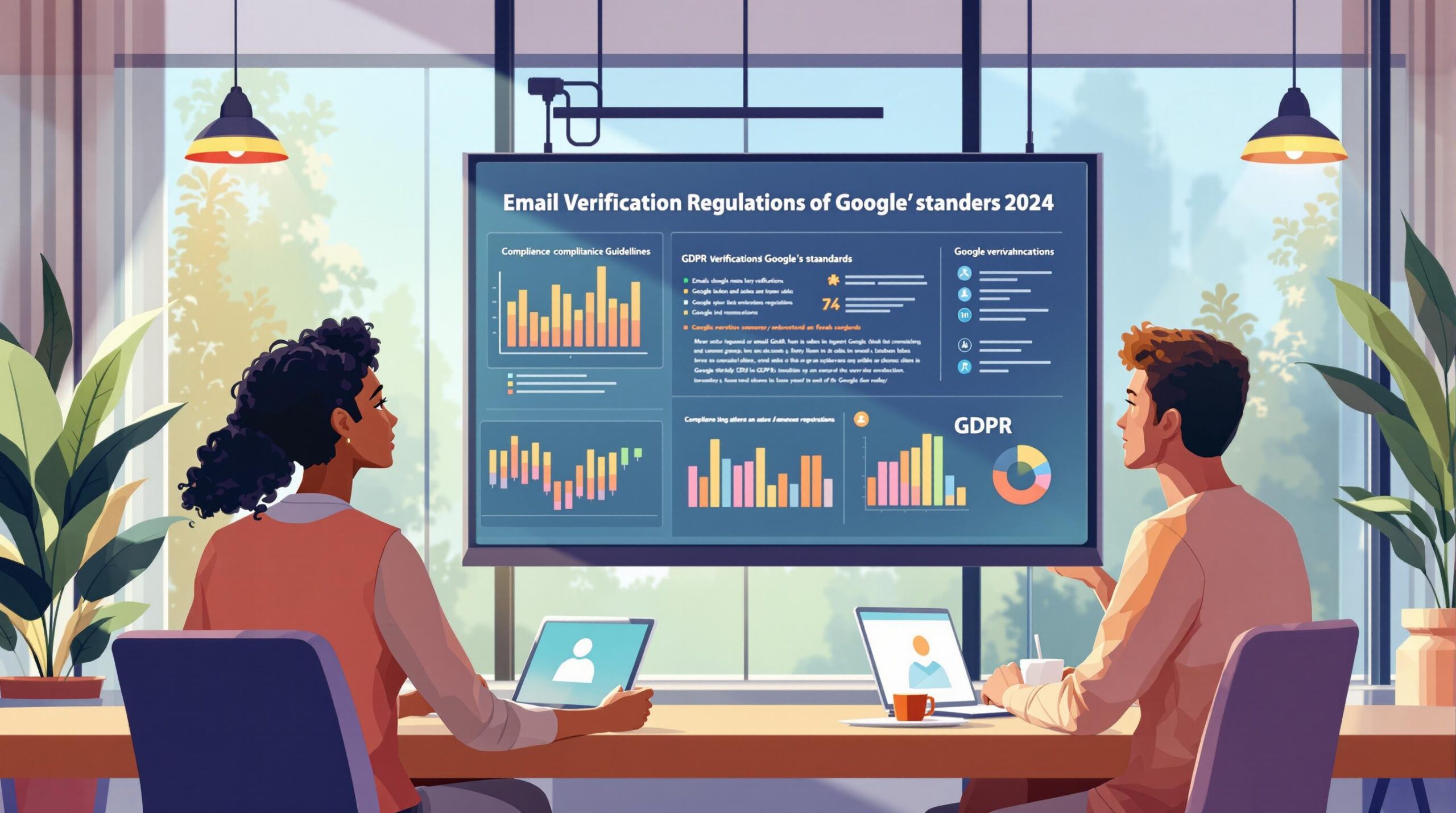In 2024, email verification became a critical compliance requirement due to stricter global regulations like GDPR and Google’s updated standards. Here’s what you need to know:
- GDPR Compliance: Requires explicit consent, double opt-ins, and regularly updated email lists. Non-compliance risks fines up to 4% of annual turnover or €20M.
- Google’s New Standards: High-volume senders must authenticate domains (DMARC, SPF, DKIM), keep spam rates below 0.1%, and process unsubscribe requests within 48 hours.
- Cross-Border Rules: Laws like CCPA and HIPAA add extra layers of data privacy and security requirements, especially for sensitive sectors like healthcare.
- Best Practices: Use real-time verification tools, maintain clean email databases, and document compliance efforts to avoid penalties and ensure email deliverability.
These regulations demand businesses adopt strict email verification methods to protect user data, maintain trust, and meet legal obligations.
Practical Steps to GDPR Compliance Success 2024
GDPR and Its Effects on Email Verification
The GDPR has reshaped how email verification is handled by introducing strict guidelines for data management and consent. These rules dictate how organizations collect, verify, and maintain their email lists, directly impacting their verification processes.
GDPR Rules That Impact Email Verification
Three key GDPR principles play a major role in email verification: consent, data minimization, and accuracy [2]. Data Protection Officers (DPOs) are responsible for ensuring that these principles are followed, including proper consent tracking and secure handling of personal data [2][4].
| GDPR Principle | What It Requires |
|---|---|
| Consent | Use explicit, double opt-in processes |
| Data Minimization | Only collect necessary email data |
| Accuracy | Keep email databases regularly updated |
How to Ensure GDPR-Compliant Email Verification
To stay compliant with GDPR, businesses need to adopt verification methods that protect user data while keeping their email lists accurate. This includes using tools that verify emails in real-time and setting up regular maintenance schedules [2][4].
Some key actions include:
- Real-time tools: Use email verification tools that also track consent.
- Database maintenance: Regularly clean and audit email lists to ensure accuracy.
For companies operating across borders, it’s essential to align not just with GDPR but also with local data protection laws. This often requires stricter verification methods and keeping detailed records of compliance efforts [2][4].
New Email Security Regulations in 2024
In 2024, Google rolled out stricter email security rules, reshaping how organizations handle email verification and authentication. These changes aim to reduce email fraud, improve delivery rates, and safeguard user privacy.
Google’s New Email Security Standards
The updated rules primarily target high-volume senders – those sending over 5,000 emails a day to Gmail users. These senders now have to meet detailed authentication criteria to ensure their emails are successfully delivered.
| Requirement | Specification | Deadline |
|---|---|---|
| Spam Rate Threshold | Below 0.1% | Immediate |
| Warning Threshold | 0.3% | Immediate |
| DMARC Setup | Mandatory for custom domains | April 2024 |
| Unsubscribe Processing | Must be completed within 2 days | June 2024 |
Impact on Businesses
Businesses must align with Google’s requirements by June 2024, with some already in effect. To comply, organizations need to authenticate their custom domains using DKIM, SPF, and DMARC protocols, keep spam rates under 0.1%, and handle unsubscribe requests within 48 hours. Falling short could lead to poor email delivery rates and damage to a business’s reputation [3].
To meet these demands, companies are adopting thorough verification methods, such as real-time email checks during data collection and frequent database updates to minimize bounce rates [3][5]. These efforts help businesses maintain reliable email delivery while adhering to Google’s strict standards.
Although Google’s guidelines apply worldwide, businesses operating internationally must also navigate added data privacy concerns that require careful management.
sbb-itb-f42cab2
Cross-Border Data Privacy and Email Verification
As businesses face growing global regulations, managing cross-border compliance has become a crucial part of email verification. Companies must juggle multiple legal frameworks while maintaining efficient and compliant email verification processes.
Other Key Regulations
In addition to GDPR and Google’s guidelines, several other laws influence email verification practices. For instance, the California Consumer Privacy Act (CCPA) outlines specific rules for handling data from California residents. Under CCPA, companies must address the following:
| Requirement | Description | Implementation |
|---|---|---|
| Opt-Out Mechanisms | Provide clear ways for users to opt out of data collection | Include unsubscribe buttons and preference centers |
| Identity Verification | Ensure secure methods to confirm user identity for data requests | Use multi-factor authentication systems |
| Data Access Rights | Respond promptly to requests for personal information access | Automate systems to handle requests within 45 days |
In healthcare, HIPAA compliance introduces additional challenges. Organizations in this sector must adopt secure email verification processes to protect Protected Health Information (PHI) while ensuring smooth communication.
Effectively managing these various regulations demands a well-organized approach to maintain compliance across different regions.
Compliance Strategies for Cross-Border Operations
To handle cross-border compliance effectively, businesses can adopt these strategies:
- Data Protection Standards: Certifications like ISO 27001 and SOC2 establish strong security measures, helping organizations meet multiple regulatory requirements.
- Centralized Compliance Management: Tools such as Bouncebuster provide real-time email verification and automated compliance checks, simplifying operations across borders.
-
Technical Implementation: Advanced technical solutions are essential for compliance. These include:
- Data mapping and region-specific protocols to track information flow and meet local laws.
- Detailed audit trails to monitor activities and ensure systems stay updated with changing regulations.
Email Verification Best Practices in 2024
As global regulations become stricter, email verification is now more important than ever. Businesses need to ensure their email practices comply with these rules while keeping their operations efficient and effective.
Choosing the Right Email Verification Tools
The best email verification tools should deliver quick API responses, handle bulk email lists, comply with regulations like GDPR and CCPA, and integrate easily with CRMs. Tools such as Bouncebuster are designed to meet these needs, offering real-time checks and smooth integration options [2][4].
Adding Verification to Your Workflows
Incorporating email verification into your processes is all about timing. Focus on these key moments:
- At the Collection Stage: Verifying email addresses in real time as they’re collected helps you avoid invalid entries and stay GDPR-compliant. This step ensures your database starts off clean.
- During Database Updates: Regularly verifying your existing email lists keeps them accurate and ensures compliance. Ongoing checks are essential for maintaining high deliverability rates and meeting regulatory standards.
Keeping Your Email List Clean
A well-maintained email database is crucial for compliance and performance. Perform quarterly audits to check bounce rates, engagement metrics, and consent records. Automated tools can help you spot and remove invalid or low-quality addresses, ensuring your list stays up-to-date and reliable.
Documenting your verification processes is equally important. It not only proves your efforts to stay compliant but also highlights areas where your workflow could improve. By following these steps, you’ll boost deliverability and meet the requirements of regulations like GDPR, CCPA, and HIPAA [2][4].
Navigating Email Verification Regulations
Tighter regulations mean businesses need to stay sharper than ever. For example, Google’s updated 2024 email security standards focus on keeping spam rates low and ensuring domain authentication, while GDPR continues to stress clear consent and accurate data handling [1][3].
To meet these demands, businesses must adopt solid email verification practices. Tools like Bouncebuster make this process easier by offering real-time and bulk email verification, helping companies stay compliant and safeguard their reputation. This is especially important for businesses operating across regions with varying rules [2][4].
Failing to comply can lead to serious issues, such as tarnished sender reputations or even legal penalties under GDPR [2][5]. To avoid these pitfalls, businesses should focus on maintaining verified email databases, securing proper authentication, and conducting regular audits. Verification tools play a key role in strategies like real-time checks and database reviews.
With regulations expected to tighten further, staying compliant is not just about avoiding fines – it’s also about building trust with your audience and ensuring your emails actually reach them.



